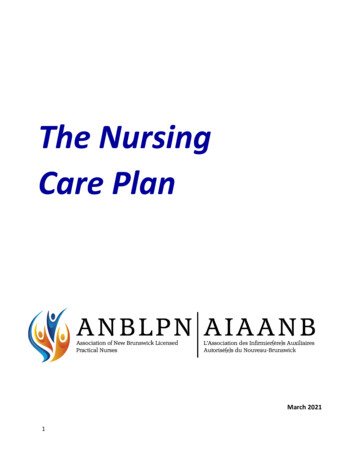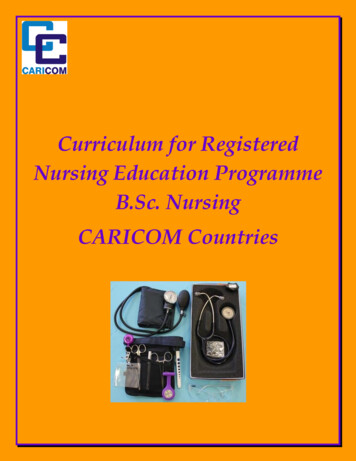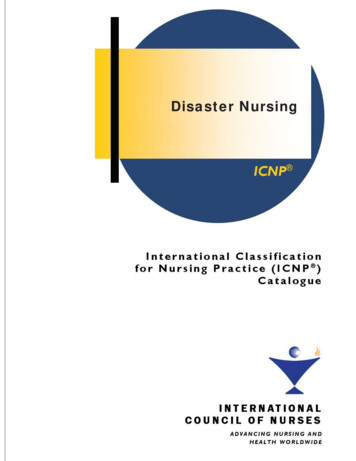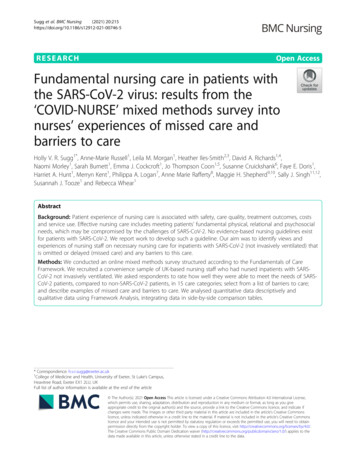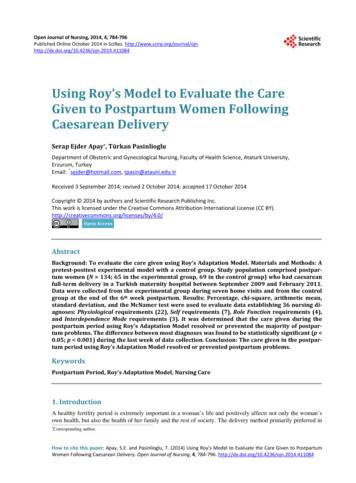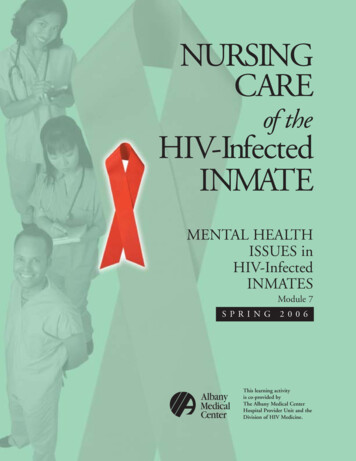
Transcription
NURSINGCAREof theHIV-InfectedINMATEMENTAL HEALTHISSUES inHIV-InfectedINMATESModule 7SPRINGAlbanyMedicalCenter2006This learning activityis co-provided byThe Albany Medical CenterHospital Provider Unit and theDivision of HIV Medicine.
MISSION:This module is designed to equip correctionalnurses with the basic knowledge needed toprovide safe, comprehensive care to inmatesinfected with HIV. Each module providesan overview of a pertinent topic so thatcorrectional nurses have a reference toolreadily available for their care ofHIV-infected inmates. To obtain copiesof Modules 1 – 5, please visit AlbanyMedical College’s website at:www.amc.edu/Patient/hiv/index.htm(go to correctional education).LEARNING OBJECTIVES:After reading this monograph, the correctionsnurse should be able to:1) Discuss the impact of mental illness onHIV transmission and on HIV treatmentadherence.2) Describe central nervous systemmanifestations resulting from HIVinfection.3) Discuss the association of HIV disease,mental illness and substance abuse.4) Identify pharmacologic considerationsin the treatment of mental disorders inHIV-infected inmates.D I S C L O S U R E S TAT E M E N T :The monograph author, Minda Hubbard,is a member of the Speakers’ Bureaus of thefollowing companies: Boehringer IngelheimPharmaceuticals, Inc., Bristol-Myers SquibbVirology, Gilead Sciences, Inc & RocheLaboratories Inc.ACKNOWLEDGEMENTS:This publication is supported by anunrestricted educational grant from GileadSciences, Inc. Thank you to the New York/New Jersey AIDS Education & TrainingCenter (AETC) for their support in thedevelopment of this resource.We gratefullyacknowledge Columbia University HIVMental Health Training Project for theirexpertise and contributions to thismonograph.AUTHOR & COURSED I R E C TO R :Minda J. Hubbard, MSN, ANP-CResearch Nurse PractitionerDivision of HIV MedicineAlbany Medical CollegeAlbany, NYE D I TO R I A L B OA R D :Douglas G. Fish, MDMedical DirectorAIDS Designated CenterAssistant Professor of MedicineAlbany Medical CollegeAlbany, NYCharles J. Moehs, MD, MPHFacility Medical DirectorCape Vincent Correctional FacilityCape Vincent, NYProject ManagerSarah J. Walker, M.S.Associate Director ofHIV Correctional EducationDivision of HIV MedicineAlbany Medical CollegeAlbany, NYNurse PlannerDiane Kozak, RN, MS, BCDepartment of Education & DevelopmentAlbany Medical CenterAlbany, NYProduction AssistantJim YbarraEducation and Outreach AssistantDivision of HIV MedicineAlbany Medical CollegeAlbany, NYN U R S I N G A C C R E D I TAT I O N :The Albany Medical Center Hospital isaccredited as a provider of continuing nursingeducation by the American NursesCredentialing Center’s Commission onAccreditation.
NURSING CARE of theHIV-Infected INMATEL E A R N I N G M O D U L E 7 : M E N TA L H E A LT H I S S U E S i nH I V- I N F E C T E D I N M AT E SMODULE DIRECTIONSA B O U T C O N T I N U I N G E D U C AT I O N C R E D I T :To obtain Continuing Nursing Education credit, a minimum of 80% of the questions must beanswered correctly on the self assessment test on page 13. The estimated time for completionof this activity is 1 hour.There is no fee for the nursing continuing education credit for this monograph. This learningactivity is awarded 1.0 contact hour through June 30, 2006.IMPORTANT: READ THESE INSTRUCTIONS BEFORE PROCEEDING!DIRECTIONS:1. Time yourself throughout all portions of this activity.2. Read the enclosed monograph.3. Take the self assessment test.4. Fill out the program evaluation. Please be sure to include the length of time it took youto complete the activity, self assessment test, and evaluation.5. Complete the reader information form including your name and address.6. Fully complete the HRSA participant information form in black pen. Each bubble mustbe fully shaded.7. To assure your receipt of Continuing Nursing Education credit, please mail your completedself assessment test, program evaluation, reader information form and HRSA participantinformation form (3 pages total) to:Jim YbarraAlbany Medical College47 New Scotland Avenue, Mail Code 158Albany, NY 12208If you have any questions, please contact Jim Ybarraat (518) 262-4674 or ybarraj@mail.amc.edu.Awarding of Nursing Continuing Education Contact Hoursand/or the Accreditation of Albany Medical Center HospitalProvider Unit by the American Nurses’ CredentialingCenter’s Commission on Accreditation does not implythat the Commission on Accreditation or Albany Medical Centerendorses or approves of any product or vendor.Nursing Care of the HIV-Infected Inmate: Mental Health Issues in HIV-Infected Inmates M O D U L E7PA G E 1
NURSING CARE of the HIV-Infected INMATELEARNING MODULE 7: MENTAL HEALTH ISSUES for the HIV-INFECTED INMATESINTRODUCTIONProviding health care to the HIV-infectedinmate is challenging on many levels. HIV is acomplex multi-system disease. Treatment requiresstrict medication adherence to avoid drugresistance. Many drug-drug interactions exist.Common co-morbidities in this population such ashepatitis B and C complicate treatment even more.Psychiatric co-morbidity is a significant issueamong HIV-infected individuals, even more soamong the incarcerated. Substance abuse, mentalhealth disorders and HIV disease frequently presenttogether and create risks for disease transmissionand problems with treatment adherence. Thepurpose of this learning module is to familiarize thecorrectional nurse with ways to identify andmanage HIV-infected inmates with mental healthdisorders.Inmates suffer from a disproportionately highrate of mental illness. Of the 2.1 millionincarcerated individuals in the country, one out offive suffers from serious mental illness and at least13% of inmates will have an acute episoderequiring psychiatric care at some point duringtheir incarceration (Veysey et al, 2002). Mentalhealth problems are more prevalent among peoplewith less education, fewer social supports and poorcoping mechanisms. Many inmates have thisconstellation of risks in their backgrounds. Otherfactors associated with a mental health disorderinclude: History of violence Family or personal history of mental illness History of prior incarceration Inadequate housing Chronic pain Multiple medical problems(Bookhardt-Murray, 2002)Female inmates have higher rates of depression andpost traumatic stress disorder (PTSD) related tosignificant physical and sexual abuse histories(60-90%) (Hutton et al, 2001). Little data arePA G E 2available estimating psychiatric disorders in the jailpopulations due to their transient nature and shortduration of stay. However, recent statisticspertaining to inmates in the state facilities estimate:13-18% have major depression; 22-30% havePTSD; 26-45% have antisocial personality disorderand 6-12% have anxiety disorder (this rises to 32%in inmates with opiate-dependence) (Veysey et al,2002).Individuals with untreated mental illness are atgreat risk for HIV transmission due to thelikelihood of risky behaviors (needle-sharing forintravenous drug use and unprotected sex). Inaddition, once HIV-infected, these patients are lesslikely to adhere to their medical appointments andtreatment regimens, often resulting in poor clinicaloutcomes (Angelino and Treisman, 2006).HIV-ASSOCIATED DEMENTIAPsychiatric symptoms in the person infectedwith HIV may be a result of HIV itself. Subtlechanges in cognition can be the result ofHIV-associated dementia (HAD). It can be difficultto differentiate these symptoms from those of aprimary psychiatric disorder. The effects of HIV onthe central nervous system (CNS) occur soon afterinitial infection. Although the virus does notdirectly infect neurons, damage is caused byneurotoxins released by both the virus and infectedcells in the CNS. The virus crosses the blood-brainbarrier readily. Even in patients with undetectableserum HIV, detectable virus can exist in the CNS.Patients can present with a range of abnormalneurocognitive symptoms. Common symptomsof HAD are forgetfulness, problems withword-finding, decreased visual/motor skills andmental slowing. CT and MRI scans as well aslumbar puncture are useful diagnostic tools todetermine the source of pathology. Table 1highlights the range of disorders to beconsidered in the HIV-infected patient withneurocognitive symptoms.If the patient is not on HIV treatment, or is ona treatment regimen that is not fully suppressinghis/her HIV viral load, the risk for HIV-relatedcomplications of all sorts is higher. The bestNursing Care of the HIV-Infected Inmate: Mental Health Issues in HIV-Infected Inmates M O D U L E7
TABLE 1CLINICAL MANIFESTATIONS OF HIV-ASSOCIATED DEMENTIATYPE OF IMPAIRMENTMANIFESTATIONSAffective-Apathy (depression-like features)-Irritability-Mania, new-onset psychosisBehavioral-Psychomotor retardation (slowed speech or response time)-Personality changes-Social withdrawalCognitive-Lack of visuospatial memory (misplacing things)-Lack of visuomotor coordination-Difficulty with complex sequencing(difficulty in performing previously learned complex tasks)-Impaired concentration and attention-Impaired verbal memory (word-finding ability)-Mental slowingMotor-Unsteady gait, loss of balance-Leg weakness-Dropping things-Tremors-Poor handwriting-Decline in fine motor skillsHIV Clinical Guidelines for the Primary Care Practitioner: Mental Health Care for People with HIV Infection.www.hivguidelines.orgtreatment for HAD is HIV viral suppression withhighly active antiretroviral therapy (HAART).Advanced immunosuppression, (CD4 count 200cells/mm), puts the patient at greater risk for bothopportunistic infections of the CNS and metabolicabnormalities that affect cognitive function. Sincesymptoms can mimic those of a primary psychiatricdisorder and substance abuse, accurate diagnosis isnecessary to ensure appropriate treatment. Aninfectious disease specialist should be consulted forthe HIV-infected inmate with neuropsychiatricsymptoms (Forstein, 2003).An additional consideration in the correctionalsetting is that inmates suffering from undiagnosedHAD may have problems with impulse control,adhering to rules and making simple decisions.These behaviors may put them at risk for problemswith correctional staff and with other inmates.They may refuse medications due to an inability tounderstand cause and effect, and consequences.Medication refusal should serve as a red flag forHAD (Herfkens, 2001).Screening for HAD can be accomplished usingone of several quick tools such as the JohnsHopkins Dementia Scale: www.hivguidelines.org/public html/mh-cog/mh-cog-appa.htm Screeningclose to the time of prison intake should be avoidedas results may be skewed by any recent substanceabuse, and by the higher rate of depression at thispoint in incarceration. Abnormal results should berepeated at a later date.Nursing interventions for the patient with HADcan be critical in successful management. Someinterventions include: Use of written reminders and simpleinstructions Repetition of all instructions Use of pill boxes, timers and familymembers to stay on track with medicationsupon discharge Orienting confused inmates to time, placeand personNursing Care of the HIV-Infected Inmate: Mental Health Issues in HIV-Infected Inmates M O D U L E7PA G E 3
Medications: some of the many medicationsthat can cause delirium are anticholinergics,antihistamines, sedatives, theophylline, digoxin,corticosteroids, benzodiazepines andrecreational drugs including alcohol. Assess ifthe patient has recently started any newmedications; screen for possible exposure toillegal substances. Redirecting/distracting inmates frominappropriate behaviors Maintaining calm demeanor with confusedor agitated inmatesPatients with CD4 cell counts 200 cells/mmmay exhibit a more subtle version of some of thesame symptoms observed in HAD. This is knownas minor cognitive motor disorder. These patientsshould be started on HAART to control HIV viralreplication. Infection: particularly in the patient who isimmunocompromised, work-up for any sourcesof infection, (even in the absence of fever),should be aggressive (see Table 2).DELIRIUMDelirium is an acute or subacute change in levelof consciousness. Patients wax and wane in theirability to maintain attention. In the setting ofco-existing substance abuse, the diagnosis ofdelirium is often missed. Immediate medicalattention is required. There are three major causesof delirium:TABLE 2 Metabolic: potential causes of delirium arehypoxemia, hyperglycemia, hyponatremia,hypercalcemia, hypotension and seizures.Treatment for delirium entails promptidentification and treatment of the cause. TheOPPORTUNISTIC INFECTIONS/NEOPLASMS OF THECENTRAL NERVOUS SYSTEMDIAGNOSISCAUSECD4 COUNTTREATMENTNURSING IMPLICATIONToxoplasmosisParasite 100 cells/mmPyrimethamine Folinic acid SulfadiazineTreatment is lifelong; monitor CBC,renal function; encourage hydrationCryptococcalmeningitisfungus 200 cells/mmAcute treatment:AmphotericinMonitor BP during infusion; watch RFTsMaintenance:DiflucanMonitor CBC and LFTsPMLvirus 50 cells/mmHAARTHigh mortality rateCMV encephalitisvirus 50 cells/mmGanciclovir/FoscarnetHigh mortality rateCNS lymphomamalignancy 100 cells/mmRadiationTreatment is palliative; high mortality rateNeurosyphilisbacteriaanyPenicillinMonitor RPR annually on all HIV patientsTuberculosismeningitisbacteriaanyAnti-TB medicationfor 12-18 monthsMonitor PPD annually on all HIV patients,unless previously positiveHIV/AIDS Nursing Secrets, 2003PA G E 4Nursing Care of the HIV-Infected Inmate: Mental Health Issues in HIV-Infected Inmates M O D U L E7
patient should be oriented to time and placeregularly. In severe cases, sedation may benecessary. These patients need close, frequentmonitoring.SUBSTANCE ABUSERates of mental health disorders amongsubstance abusers are quite high: major depressivedisorder 34%, antisocial personality 68% and aneight-fold increase in attempted suicide. Addictionproblems frequently co-exist with mental healthdisorders, and lead to incarceration in many cases.In the months just prior to incarceration, 64-70%of inmates abuse illegal substances. The link toHIV prevalence among this group is strong. InNew York State prisons, 93% of AIDS patientshad histories of substance abuse (Altice andSpringer, 2005).Underdiagnosed and undertreated mentalhealth problems among substance abusers cancontribute to the spread of HIV. Significantassociations have been made between bothdepression and anxiety, and needle-sharing;adequate treatment for mental health disordersTABLE 3has been linked to less needle-sharing (Lundgren etal, 2005).Active substance abuse often results in poortreatment adherence. Female inmates reportextremely high rates of unprotected sex withintravenous drug users, putting them at great riskfor HIV infection (Belyea, 1999). Intravenousdrugs are not the only recreational substanceslinked to HIV transmission. Cocaine abusers havehigher rates of trading sex for drugs. Alcohol abuseis linked to lowered inhibition which can lead torisky sexual behaviors. The recent rise inmethamphetamine use is of great concern due to itseffects on increasing libido while decreasinginhibitions. Contrary to popular belief, however,substance abuse disorders can be successfullytreated. An AIDS clinic in inner city Baltimorewith a significant percentage of drug abuse amongits clients reports that one-third of their patientshave been able to achieve long-term recovery fromsubstance abuse (Treisman, 2003).Symptoms of substance abuse can often lookmuch the same as those of HIV: malaise, fatigue,sweats, fevers, weight loss. HIV-infected substanceRECOMMENDED MENTAL HEALTH SCREENINGFOR PATIENTS WITH HIVASSESS AT INTAKE AND THEN ANNUALLY: Cognitive impairment Depression Anxiety Sleep habits and appetite Suicidal/violent ideation Post-traumatic stress disorder Psychosocial status Past psychiatric history (meds, hospitalizations) Alcohol and substance use Stigmatization issues (due to HIV, substance abuse,sexual identity)CLINICAL MONITORING FOR HIV-INFECTED PATIENTS WITH MENTAL HEALTH SYMPTOMS: Thyroid function tests B12 level Folate Cortisol level Chemistries and electrolytes Liver function tests Complete blood count Testosterone level Rapid plasma reagen (RPR) Glucose levelwww.hivguidelines.orgNursing Care of the HIV-Infected Inmate: Mental Health Issues in HIV-Infected Inmates M O D U L E7PA G E 5
abusers have higher rates of medical complicationssuch as bacterial infections (pneumonia, meningitis,endocarditis, sepsis), tuberculosis, sexuallytransmitted diseases, hepatitis B and C, andlymphomas.Mental health disorders such as depression andaffective disorder frequently overlap with substanceabuse. These patients are at high risk for worseningaddiction, poor treatment outcomes and evensuicide. Referral to a psychiatrist for evaluation iscritical. Treatment for both addiction issues andpsychiatric illness should be initiated duringincarceration, and will need to be included in theinmate’s release plan. Long-term treatment is thebest way to maintain recovery behaviors andadherence to HIV treatment.It is very important to communicate with thecommunity substance abuse treatment providersregarding inmates on HIV medications. Significantdrug interactions exist between methadoneand several antiretrovirals. Inmates takingnon-nucleoside reverse transcriptase inhibitors(NNRTIs: efavirenz, delavirdine or nevirapine) cango into withdrawal if methadone levels are notcarefully monitored. Several protease inhibitors(PIs) also have drug interactions (Bartlett, 2005).DEPRESSIONAs previously stated, prevalence of depressionamong inmates is quite high. The experience ofbeing incarcerated frequently results in depression.HIV-infected patients suffering from depressionhave higher mortality rates and may experiencegreater immune compromise than those withoutdepression (Clinical Manual for Management of theHIV-infected Adult, 2005).In patients with HIV, there are certain riskperiods for depression: the time of initial diagnosis,periods of clinical instability such as developingsymptoms or illness, disclosure of HIV status tofamily and friends, introduction of medication,death of a significant other, and progression toAIDS diagnosis. Depression that occurs as a resultof these negative experiences is termed reactivedepression (adjustment disorder, demoralization).Patients are reacting to a specific situation in theirlives but maintain the ability to be distracted fromit and enjoy other parts of their lives.In contrast, patients experiencing majordepression (endogenous) are not able to experiencemuch pleasure in other aspects of their lives. BothPA G E 6of these syndromes can present with a variety ofsomatic complaints such as abdominal pain,headache, backache, insomnia, fatigue and cardiacsymptoms. Possible symptoms of depression are: Depressed mood, sadness, hopelessness Insomnia or hypersomnia Fatigue or loss of energy Decreased ability to concentrate Recurrent thoughts of death or suicide Diminished interest or pleasure in activities Appetite changes with weight changes(up or down) Feelings of worthlessness or guilt Psychomotor agitation or retardationPatients with five of these symptoms occurringmore days than not for at least two weeks havemajor depression. These patients should have animmediate psychiatric evaluation as they are at highrisk for suicide. Patients with reactive depressionwill have at least one of the five symptoms. In bothcases, prompt psychiatric evaluation can result ininitiation of treatment with medications andcounseling, with a good chance for managingsymptoms. The patient should always be worked upfor other potential causes of symptoms, as notedearlier (Angelino and Treisman, 2006).There are a number of easily-administeredscreening tools available for depression. The BeckDepression Inventory and General HealthQuestionnaire are short, reliable tools that can beadministered to all HIV-infected inmates. Screeningcan be simplified even further by asking the inmateif during the past month he/she has (1) experiencedlittle pleasure in doing things and (2) felt down,depressed or hopeless. Those with positive resultsshould be referred to psychiatry (Treisman andAngelino, 2003).Treatment for depression is highly effective, witha high proportion of patients experiencing at leastsome improvement of symptoms within the firstthree months. Although anti-depressants all haveside effects, medications can be selected that willhelp manage other symptoms the patient might beexperiencing. For instance, an inmate withNursing Care of the HIV-Infected Inmate: Mental Health Issues in HIV-Infected Inmates M O D U L E7
insomnia and/or weight loss can be given doxepin,desipramine or nortriptyline which causedrowsiness and weight gain. All medications shouldbe started at low dose and titrated up whilemonitoring the patient’s tolerance. It can take up tofour to six weeks to see a response after treatmentinitiation. Even when symptoms of depressionresolve, it is recommended to continue the patienton treatment to avoid recurrence (Angelino andTreisman, 2006).Drug interactions should be assessed asantiretrovirals, especially ritonavir, can interactwith anti-depressants. HIV-infected patients onanti-depressant medications should be closelymonitored (Mann, 2005). Tables 4 & 5 on pages9 and 10 outline interactions between HIV andmental health medications. Paroxetine should beavoided in pregnant patients (FDA, 2006). Patientswho will be undergoing treatment for hepatitis Cinfection are at high risk for interferon-induceddepression. These patients may need to be startedon an anti-depressant early during the course oftreatment. Some clinicians will even start thepatient on anti-depressant therapy prior to theinitiation of hepatitis C treatment.ANXIETY DISORDERAnxiety disorder can overlap with depressionand also occur more frequently in inmates atthe time of incarceration as well as at varioustime-points related to HIV (initial diagnosis anddisease progression). Such episodes related to lifeevents are usually transient. True anxiety disorder isdefined as unrealistic, excessive worry about two ormore life circumstances with at least six of thefollowing complaints: Sweating or cold, clammy hands Dry mouth Skin rashes Dizziness/lightheadedness Nausea, diarrhea or other abdominal distress Flushes or chills Frequent urination Dysphagia/”lump in throat” Feeling keyed up or on edge Exaggerated startle response Difficulty concentrating Trouble falling or staying asleep IrritabilityThe inmate should be questioned about familyhistory of psychiatric problems as well as any recentstress or sleep disturbances. Caffeine intake and allmedications should also be assessed to look forother sources of symptoms. A physical exam andlaboratory evaluation should be done to rule outcardiac, thyroid or metabolic disturbances.The psychiatrist or primary care provider cantreat the inmate with anxiolytics such as buspirone,venlafaxine or escitalopram. Benzodiazepines shouldbe used for short term, only in patients with severeanxiety disorder. Midazolam and triazolam arecontraindicated with all protease inhibitors andwith efavirenz and delavirdine(www.hivguidelines.org).BIPOLAR (MANIC/DEPRESSIVE) DISORDERBipolar disorder occurs in approximately 8% ofpeople living with HIV/AIDS (ten times higherthan among non-infected people). Generally, theonset of symptoms is late adolescence/earlyadulthood with a strong genetic component. Thepatient experiences moods vacillating between longperiods of depression and extended cycles ofelevated, euphoric moods. The latter arecharacterized by high energy, insomnia, irritabilityand inflated self-thinking (hypomania). Theemotions are disconnected from the environmentand progress to a state known as mania with highlydisorganized thoughts, hallucinations and delusions.Particularly during the manic phase, judgment isimpaired and high risk behavior is common,contributing to HIV transmission and difficultywith medication adherence.These patients require assessment, treatment andmonitoring by mental health providers. Treatmentusually consists of therapy and medications withmood stabilizing drugs and/or anticonvulsants. Aswith all other medications, be alert for drug/druginteractions in patients on HAART. Of particularnote, carbamazepine has significant interactionswith NNRTIs, PIs and lamivudine (Treisman andAngelino, 2003).Nursing Care of the HIV-Infected Inmate: Mental Health Issues in HIV-Infected Inmates M O D U L E7PA G E 7
PERSONALITY DISORDERSPSYCHOTIC DISORDERSIt is beyond the scope of this learning moduleto address all of the mental health disordersencountered in corrections. Some of the mostprevalent personality disorders found among theinmate population are borderline, antisocial andhistrionic patients. These are perhaps the mostdifficult inmates to manage as they often displaymanipulative behavior designed to split the staff.Common to all of these disorders is a tendencytowards impulsivity, sensation seeking andneuroticism. All require a full psychiatricevaluation for therapy and medicationrecommendations. A comprehensive treatmentplan developed with the entire staff, includingpsychiatry, is essential. Consistency among staffand frequent re-evaluation of the plan can have asignificant positive effect. Management strategiesinclude:People with a history of psychotic disorder areincreasingly common among inmates. A report of49 surveys of psychotic illness in incarceratedpopulations revealed that 3.7% of male prisonersand 4.0% of female prisoners had psychotic illness(Fazel & Danesh, 2002).This means that there is a two to four foldexcess of psychotic illness in prisons whencompared to the general population. People withpsychotic illness are much more likely than thegeneral population to be HIV infected (Cournos &Bakalar, 1996). These individuals will most likelybe treated with both anti-retroviral andpsychotropic medications. Significant druginteractions can be problematic in such patientsand expert consultation is best when beginning orchanging either class of medication. Avoid issuing ultimatums (they result in powerstruggles and worsen the problem). Instead,appeal to cognitive capabilities to set clear andrealistic goals. Set consistent, firm limits on negativebehaviors. Reward positive behaviorsCONCLUSIONCaring for the inmate with HIV and mentalhealth disorders requires the efforts of the entiremedical team, including ongoing assessment andadequate discharge planning. The needs of this typeof patient are significant; treatment of mentalhealth disease will lead to improved HIV treatmentadherence, better clinical outcomes and reducedrisk of HIV transmission. Assess suicidal ideation(Clinical Manual for Management of theHIV-infected Adult, 2005).PA G E 8Nursing Care of the HIV-Infected Inmate: Mental Health Issues in HIV-Infected Inmates M O D U L E7
BENZODIAZAPINEMEDICATION (Brand Name)INTERACTIONFluoxetine (Prozac)See * below. a, b, cCitalopram (Celexa)Could be affected by RTV, monitor for toxicity. Of SSRIs,this agent is less likely to be affected by Pls.Sertraline (Zoloft)Side effects are similar to those noted for Prozac, but areless severe due to shorter half-life. a, b, cParoxetine (Paxil)Promotes sleep; initial dose is 20 mg/d; increase by 10 mgincrements. Less likely to interfere with other medicationsthan other SRIs. dFluvoxamine (Luvox)a, b, cVenlafaxine (Effexor)a, bBuspirone (BuSpar) Nonbenzodiazepine-nonbarbiturate; dependence liabilitynegotiable; increase dose 5 mg q 2-4 days to effectivedaily dose of 15-30 mg.* Not likely to be affected by PIs or NNRTIs.Amitryptyline (Elavil)dDoxepin (Sinequan)dNortriptyline (Aventyl, Pamelor)Titrate level (70-125 mg/dl). promotes sleep. dDesipramine (Norpramin)Desipramine ( 125 ng/dl). promotes sleep. dNefazodone HCI (Serzone)a, b, cBupropion (Wellbutrin/Zyban)Initial dose is 150 mg bid; increase to 300 mg/day after 3days, as necessary. a, b, cHaloperidol (Haldol)dChlorpromazine (Thorazine)dRespiridone (Respirdal)dImipramine (Tofranil)dThioridazine (Mellaril)dPerphenazine (Trilafon)dLithiumNot affected by PIs or NNRTIsOlanzapine (Zyprexa)a, b, dValproic Acid (Depakote, Divalproex)a, b, cDiazepam (Valium)d, eClonazepam (klonopin)b, d, eAlprazolam (Xanax)b, d, eTemazepam (Restoril)b, d, eLorazepam (Ativan)b, d, eCOMMENTS KEY:a - potential levels by efavirenz (EFV)nevirapine (NVP; clinical significanceunclear, monitor for sub-therapeuticeffectb - potential levels by ProteaseInhibitors (PIs); clinical significanceunclear, monitor for toxicityc - potential levels of PIs and Nonnucleoside Reverse TranscriptaseInhibitors (NNRTIs); clinicalsignificance unclear,monitor for toxicityd - possible levels by ritonavire - Metabolites could be affected byPIs and NNRTIs, clinical significanceunclear. Suggested start with reduceddosage and titrate up. MOODSTABILIZINGAGENTSINTERACTIONS BETWEEN HIV AND MENTAL HEALTH MEDICATIONS ANTIPSYCHOTICSOtherAgentsTricyclicsMixed AgentsANTIDEPRESSANTSSerotonin Reuptake Inhibitors(SRIs or SSRIs)TABLE 4*Major side effects are nausea, nervousness,insomnia, weight loss, dry mouth,constipation; insomnia may be treatedwith Desyrel 25-50mg hs.*tetracycline, fluoroquinolones contraindicated in pregnancyDeveloped by the HIV & Hepatitis Prison Project. References: Bartlett JG and Gallant JE. 2000-2001 Medical Management of HIV Infection. Johns Hopkins University,Baltimore, MD. 2000. Available at http://www.hopkins-aids.edu/publications/book/ch7 1std.html.Nursing Care of the HIV-Infected Inmate: Mental Health Issues in HIV-Infected Inmates M O D U L E7PA G E 9
TABLE 5PSYCHIATRIC AND HIV MEDICATION INTERACTIONSCATEGORYNNRTIsNRTIsPIsSSRIsProzac increases levelsof Rescriptor 50%NPD*Prozac may lead to increased effects of Norvir, but no doseadjustment of Norvir is needed when used in combination.Norvir increases levels of Prozac, Luvox, P
Albany Medical College Albany, NY NURSING ACCREDITATION: The Albany Medical Center Hospital is accredited as a provider of continuing nursing education by the American Nurses Credentialing Center's Commission on Accreditation. MISSION: This module is designed to equip correctional nurses with the basic knowledge needed to



